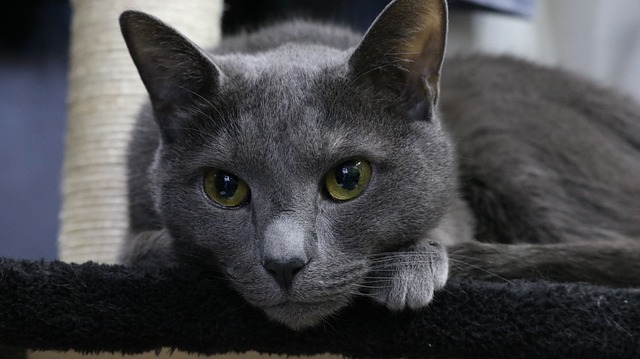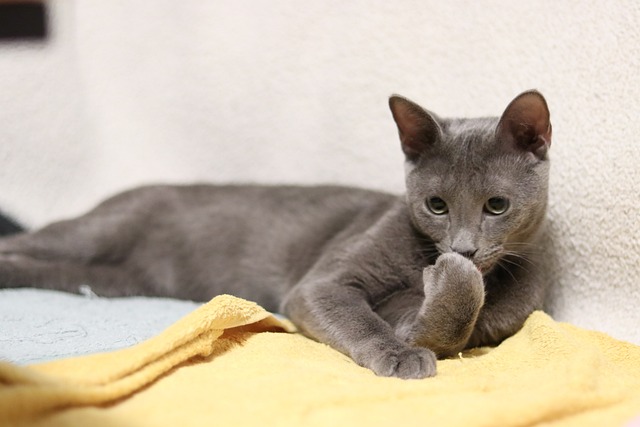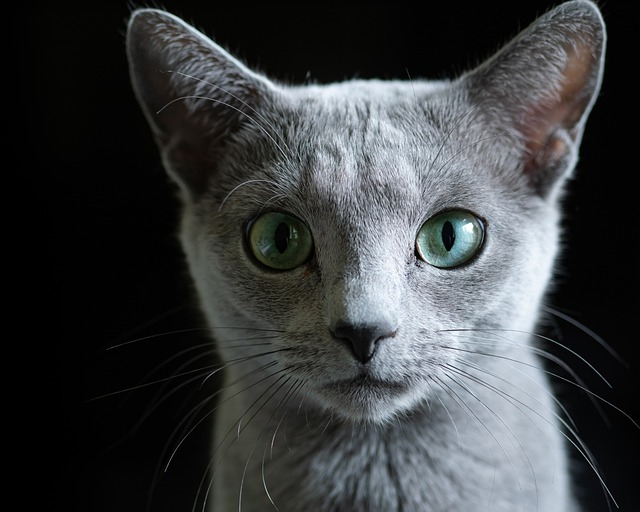History and Origins of the Russian Blue Cat Breed

The Russian Blue is a striking and elegant breed known for its shimmering silver-blue coat and captivating green eyes. Let’s explore the history, origins, and physical characteristics of the Russian Blue cat breed:
History and Origins:
The exact origins of the Russian Blue breed are somewhat mysterious, but it is believed to have originated in Russia centuries ago. The breed’s distinctive appearance and refined demeanor earned it favor among Russian aristocrats and nobility.
Russian Blue cats were first exhibited in England in the late 19th century and were initially known as “Archangel Cats,” named after the Russian port city of Archangel where they were said to have been imported. The breed gained popularity in Europe and North America during the early 20th century.
Physical Characteristics and Appearance:
The Russian Blue is known for its striking appearance and unique coat color and texture. Here are some key physical characteristics of the Russian Blue cat:
- Coat: The Russian Blue’s coat is short, dense, and plush, with a distinctly soft and silky texture. The coat is uniformly blue-gray in color, with silver-tipped hairs that give it a shimmering appearance, especially under light.
- Coloration: Russian Blues have a solid blue-gray coat color that is referred to as “blue” in the cat world. The coat should have a uniform hue across the body, with no tabby markings or white patches.
- Eyes: One of the most captivating features of the Russian Blue is its large, expressive, and vivid green eyes. The eyes are almond-shaped and set slightly apart, adding to the breed’s enigmatic and alert expression.
- Body: Russian Blue cats have a medium-sized, muscular body with a graceful and elegant build. They are agile and athletic cats, with a tendency towards a slender and lithe physique.
- Head: The head of a Russian Blue is wedge-shaped, with a straight profile and flat forehead. The ears are large and pointed, set wide apart on the head, contributing to the breed’s alert and attentive appearance.
- Personality: Russian Blues are known for their gentle and reserved demeanor. They are intelligent, curious, and affectionate cats that form strong bonds with their families. While initially reserved with strangers, Russian Blues are devoted companions once they feel comfortable.
Russian Blue cats are prized for their striking appearance, luxurious coat, and calm temperament. They make excellent indoor companions and are well-suited to households looking for a loving and loyal feline companion with a touch of elegance.
Russian Blue Cat Temperament and Personality Traits
Russian Blue cats are known for their unique temperament and distinctive personality traits. Here’s a closer look at what you can expect from a Russian Blue companion:
- Reserved Yet Affectionate: Russian Blues are typically reserved around strangers but form strong bonds with their family members. Once they trust you, they can be affectionate and loving companions.
- Gentle and Quiet: These cats are generally quiet and soft-spoken. They are not overly vocal but will communicate with gentle chirps and trills when they want attention.
- Intelligent and Curious: Russian Blues are intelligent cats with a curious nature. They enjoy exploring their surroundings and engaging in interactive play.
- Loyal and Devoted: Once a Russian Blue cat forms a bond with their human family, they are incredibly loyal and devoted companions. They often prefer to be near their favorite humans and may follow them from room to room.
- Sensitive to Routine: Russian Blues thrive on routine and may become stressed by sudden changes. They appreciate consistency in their daily schedule and environment.
- Playful and Active: Despite their calm demeanor, Russian Blues enjoy playtime and interactive toys. They are agile and athletic cats that benefit from mental stimulation and physical activity.
- Good with Other Pets: Russian Blues generally get along well with other cats and cat-friendly dogs. They can adapt to multi-pet households with proper introductions and socialization.
- Low Maintenance: Russian Blue cats are relatively low-maintenance in terms of grooming and care. They have short coats that require minimal grooming, making them suitable for busy households.
Care and Grooming Needs for Russian Blue Cats
Russian Blue cats have specific care requirements to keep them healthy, happy, and thriving. Here are essential grooming and care tips for Russian Blue cats:
- Grooming: Russian Blues have short, dense coats that require minimal grooming. Weekly brushing with a soft bristle brush or grooming glove helps remove loose hair and distribute natural oils, keeping the coat shiny and healthy.
- Regular Vet Check-ups: Schedule regular veterinary visits for preventive care, vaccinations, and health screenings. Russian Blues are generally healthy cats but benefit from routine check-ups to detect any potential health issues early.
- Nutrition: Feed a balanced and high-quality diet appropriate for your cat’s age, weight, and activity level. Provide fresh water at all times and monitor your cat’s food intake to prevent obesity.
- Litter Box Maintenance: Keep the litter box clean and scooped regularly to encourage proper litter box habits. Russian Blues appreciate cleanliness and may become stressed by a dirty litter box.
- Environmental Enrichment: Provide opportunities for mental and physical stimulation through interactive toys, scratching posts, and climbing structures. Russian Blues enjoy interactive play sessions with their human companions.
- Routine and Stability: Maintain a consistent daily routine for feeding, playtime, and sleep. Avoid sudden changes or disruptions that may cause stress or anxiety in your Russian Blue.
- Dental Care: Implement a dental care routine, including regular tooth brushing and dental check-ups, to maintain your cat’s oral health and prevent dental issues.
By providing proper care, attention, and enrichment, you can ensure that your Russian Blue cat lives a happy, healthy, and fulfilling life as a cherished family member. Their gentle nature and affectionate personality make them wonderful companions for cat lovers seeking a loyal and devoted feline friend.
Health Considerations and Common Issues in Russian Blue Cats
Russian Blue cats are generally healthy and robust cats with a lifespan of around 15 years or more. However, like all cat breeds, they may be prone to certain health conditions. Here are some common health considerations and issues to be aware of when owning a Russian Blue:
- Hypertrophic Cardiomyopathy (HCM): This is a genetic heart condition that can affect Russian Blues and other cat breeds. Regular veterinary check-ups, including cardiac screenings, can help detect signs of heart disease early.
- Gingivitis and Periodontal Disease: Russian Blues are prone to dental issues, including gingivitis and periodontal disease. Regular dental care, such as tooth brushing and dental check-ups, is essential to maintain oral health.
- Obesity: Russian Blues have a tendency to gain weight if overfed or under-exercised. Monitor their food intake and provide opportunities for regular exercise to prevent obesity-related health problems.
- Respiratory Issues: Some Russian Blues may be predisposed to respiratory issues, such as asthma or bronchial conditions. Avoid exposure to smoke, dust, or strong odors that could trigger respiratory symptoms.
- Urinary Tract Issues: Russian Blues, like many cats, may be prone to urinary tract issues, including urinary crystals or blockages. Ensure they have access to fresh water and a clean litter box to promote urinary health.
- Allergies: Some Russian Blues may develop allergies to environmental factors, such as pollen or certain foods. Monitor for signs of allergies, such as excessive scratching or skin irritation, and consult with your veterinarian if needed.
- Hyperesthesia Syndrome: This neurological condition can cause Russian Blues to exhibit skin sensitivity, tail-chasing behavior, and excessive grooming. Management may involve reducing stress and providing a calm environment.
Living with a Russian Blue Cat: Suitable Environments and Lifestyle Considerations
Russian Blue cats thrive in calm and stable environments where they can feel secure and comfortable. Consider the following lifestyle and environmental factors when living with a Russian Blue:
- Indoor Living: Russian Blues are best suited to indoor living to protect them from potential hazards and risks, such as traffic accidents or exposure to infectious diseases.
- Quiet Environment: Russian Blues appreciate peace and quiet. Minimize loud noises and disruptions to create a calm and stress-free environment.
- Consistent Routine: Establish a consistent daily routine for feeding, playtime, and rest. Russian Blues thrive on predictability and stability.
- Interactive Play: Engage your Russian Blue in regular interactive play sessions to provide mental and physical stimulation. Use toys that encourage natural hunting behaviors, such as feather wands or laser pointers.
- Comfortable Resting Areas: Provide cozy and comfortable resting areas, such as soft bedding or elevated perches, where your Russian Blue can relax and observe their surroundings.
- Quality Time: Russian Blues form strong bonds with their human companions. Spend quality time together, offering gentle affection and companionship.
- Regular Veterinary Care: Schedule regular veterinary check-ups and vaccinations to monitor your Russian Blue’s health and well-being.
By creating a nurturing and supportive environment, you can ensure that your Russian Blue cat thrives and enjoys a happy and fulfilling life as part of your family. Their gentle demeanor and affectionate nature make them wonderful companions for households seeking a loyal and devoted feline friend.
Russian Blue Cat Variations and Breeding Practices

The Russian Blue cat breed is known for its distinct appearance and unique coat color. While Russian Blues are bred to conform to a specific breed standard, variations within the breed may occur due to genetic factors and breeding practices. Here’s a look at variations and considerations related to Russian Blue cats:
Variations in Russian Blue Cats:
- Coat Color and Texture:
- Russian Blue cats should have a uniform blue-gray coat with silver tipping, giving them a shimmering appearance. Variations in coat color or markings (such as tabby stripes) are not desirable according to breed standards.
- Body Structure and Conformation:
- Russian Blues have a medium-sized, muscular build with a wedge-shaped head, large almond-shaped eyes, and prominent ears. Breeders strive to maintain these physical characteristics to adhere to breed standards.
Breeding Practices for Russian Blue Cats:
- Pedigree and Lineage:
- Responsible breeders maintain detailed pedigrees to track the lineage and genetic history of Russian Blue cats. This helps prevent inbreeding and genetic disorders within the breed.
- Health Screening:
- Ethical breeders conduct health screenings to test for genetic disorders, such as hypertrophic cardiomyopathy (HCM), which can be prevalent in Russian Blues. Cats with health issues should not be used for breeding to maintain the overall health of the breed.
- Temperament and Behavior:
- Russian Blue breeders prioritize temperament and behavior when selecting breeding pairs. Russian Blues should exhibit the breed’s characteristic traits, including a gentle and reserved nature with affectionate tendencies towards their owners.
- Maintaining Breed Standards:
- Breeders adhere to specific breed standards set by cat registries, such as the Cat Fanciers’ Association (CFA) or The International Cat Association (TICA). These standards outline the ideal characteristics and qualities of Russian Blue cats, including coat color, body shape, and temperament.
- Ethical Practices:
- Responsible breeders prioritize the health and well-being of their cats and kittens. They provide proper care, socialization, and veterinary attention to ensure healthy, well-adjusted kittens ready for adoption.
- Registration and Certification:
- Russian Blue kittens from reputable breeders are typically registered with cat associations and come with pedigrees certifying their lineage. This documentation provides assurance of the kitten’s authenticity and breeding background.
Considerations for Potential Owners:
When considering adopting a Russian Blue cat, it’s essential to research reputable breeders who prioritize responsible breeding practices. Look for breeders who are transparent about their breeding methods, provide health guarantees, and offer support and guidance to new owners.
Additionally, consider adopting from rescue organizations or shelters where Russian Blue cats may be available for adoption. Adopting from a rescue can provide a loving home to a cat in need and contribute to efforts promoting responsible pet ownership.
Overall, Russian Blue cats are a wonderful breed known for their beauty, intelligence, and affectionate nature. Whether obtained from a breeder or rescue, providing a loving and nurturing environment is key to ensuring a happy and fulfilling life for your Russian Blue companion.
50 Best Names with Meanings for Russian Blue Cats
Choosing the perfect name for your Russian Blue cat can be an enjoyable and meaningful process. Here are 50 names along with their meanings that may suit the elegance and charm of a Russian Blue:
- Sasha – Meaning “defender of mankind”
- Luna – Latin for “moon”
- Nikolai – Russian name meaning “victor of the people”
- Anya – Russian diminutive of Anna, meaning “grace”
- Caspian – Inspired by the Caspian Sea
- Aurora – Latin for “dawn”
- Leo – Latin for “lion”
- Mila – Slavic name meaning “dear one”
- Zephyr – Greek for “west wind”
- Ivan – Russian form of John, meaning “God is gracious”
- Misha – Russian diminutive of Mikhail, meaning “who is like God?”
- Aria – Italian for “air” or “melody”
- Viktor – Russian form of Victor, meaning “winner” or “conqueror”
- Nadia – Russian name meaning “hope”
- Cosmo – Greek for “order” or “harmony”
- Katya – Russian diminutive of Ekaterina, meaning “pure”
- Orion – Named after the constellation
- Tatiana – Russian name meaning “fairy queen”
- Loki – Norse god of mischief
- Mila – Russian name meaning “gracious” or “dear”
- Zara – Arabic for “princess” or “flower”
- Apollo – Greek god of music and poetry
- Nina – Russian diminutive of names ending in -nina, meaning “dreamer”
- Sable – Inspired by the Russian Blue’s coat color
- Lara – Russian diminutive of Larissa, meaning “citadel”
- Cosette – French diminutive of Nicole, meaning “victorious people”
- Dmitri – Russian form of Demetrius, meaning “follower of Demeter”
- Zephyra – Feminine form of Zephyr, meaning “west wind”
- Kira – Russian name meaning “throne” or “sun”
- Misha – Russian diminutive of Mikhail, meaning “who is like God?”
- Nikita – Russian name meaning “unconquered”
- Lara – Russian diminutive of Larissa, meaning “cheerful”
- Sonya – Russian diminutive of Sophia, meaning “wisdom”
- Rocco – Italian for “rest”
- Talia – Russian diminutive of Natalia, meaning “born at Christmas”
- Maxim – Russian form of Maximus, meaning “greatest”
- Luna – Latin for “moon”
- Oleg – Russian name meaning “holy”
- Nadia – Russian name meaning “hope”
- Zara – Arabic for “princess” or “flower”
- Yuri – Russian form of George, meaning “farmer”
- Katya – Russian diminutive of Ekaterina, meaning “pure”
- Vladimir – Russian name meaning “ruler of the world”
- Mira – Russian name meaning “peace” or “world”
- Ingrid – Scandinavian name meaning “beautiful”
- Kazimir – Slavic name meaning “destroyer of peace”
- Lena – Russian diminutive of Elena, meaning “torch” or “moon”
- Sasha – Russian diminutive of Alexander, meaning “defender of mankind”
- Olga – Russian name meaning “holy” or “blessed”
- Maksim – Russian form of Maximus, meaning “greatest”
Choose a name that resonates with you and captures the unique personality and elegance of your Russian Blue cat. Whether inspired by Russian culture, celestial themes, or timeless elegance, the perfect name will complement your cat’s beauty and charm.

In summary, the Russian Blue cat is a captivating breed known for its striking appearance, gentle temperament, and loyal nature. Originating from Russia, these cats have earned admiration worldwide for their plush blue-gray coat, vivid green eyes, and elegant physique. Russian Blues are intelligent, observant, and enjoy a calm and stable environment. They form strong bonds with their families and are known for their reserved yet affectionate demeanor. Russian Blues are well-suited for indoor living and thrive on companionship and routine. With their graceful presence and gentle disposition, Russian Blue cats make wonderful companions for individuals and families seeking a devoted and sophisticated feline friend.



























